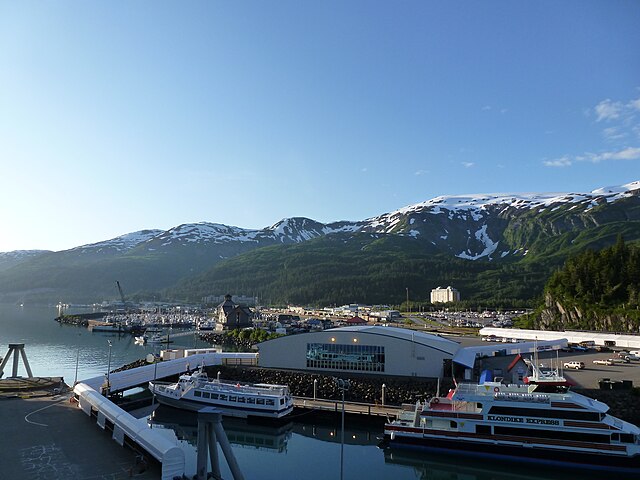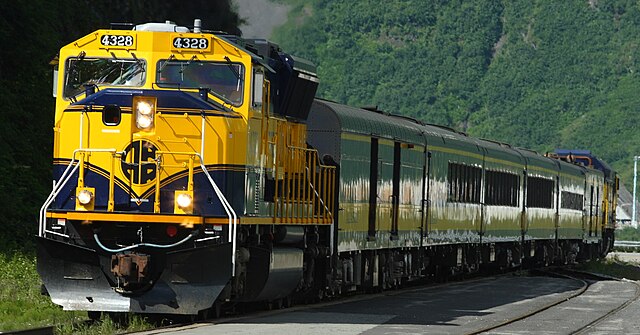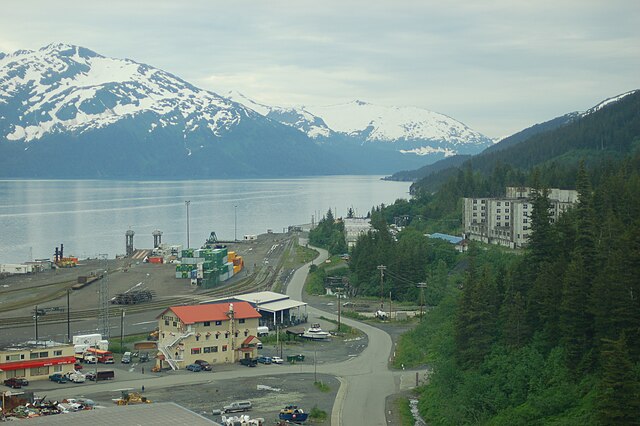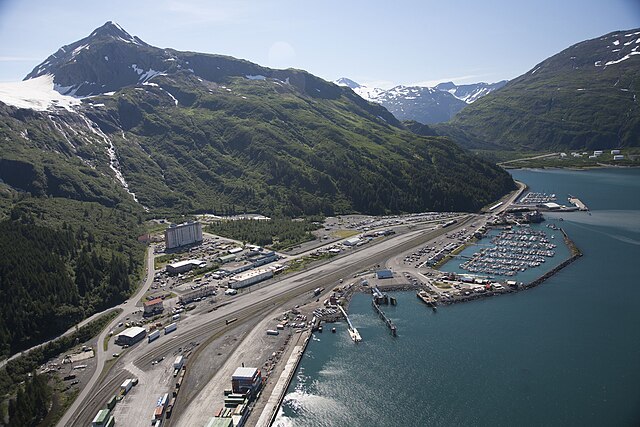Imagine a place where an entire town lives in a single building, surrounded by towering mountains, glaciers, and a sparkling bay. Sounds like something out of a sci-fi novel, right? Welcome to Whittier, Alaska, a tiny coastal community that’s as unique as it gets. Nestled at the head of Passage Canal in Prince William Sound, this town of fewer than 300 residents is a hidden gem that’s equal parts quirky, charming, and breathtaking. Whether you’re a history buff, an adventure seeker, or just curious about life in one of America’s most unusual towns, Whittier has a story to tell. Let’s dive into what makes this place so special, from its one-of-a-kind living setup to its rugged wilderness allure.
Why Whittier, Alaska, Stands Out
Whittier isn’t your average small town. Sure, it’s got stunning scenery—think snow-capped peaks and icy glaciers—but what really sets it apart is its living arrangement. Almost all of its 272 residents call Begich Towers home, a 14-story former military barracks that’s been transformed into a vertical village. Picture this: a grocery store, post office, church, and even a school, all under one roof. It’s like living in a cozy, self-contained universe. But there’s more to Whittier than its quirky housing. Its history as a secret military base, its role as a gateway to Prince William Sound, and its isolation—accessible only by a tunnel or by sea—make it a destination unlike any other.
A Town Under One Roof: The Begich Towers Phenomenon
Begich Towers is the heart of Whittier, and it’s not just a building—it’s a lifestyle. Built in the 1950s as a military barracks, this 14-story structure now houses about 90% of the town’s population. Imagine stepping into an elevator to grab groceries, visit the doctor, or attend church. For residents, it’s like living in a giant dorm, but with a lot more character. The building’s peach-colored exterior stands out against the rugged Alaskan landscape, and its underground tunnel to the school means kids don’t have to brave the brutal winter winds. It’s practical, sure, but it’s also a testament to human ingenuity in a place where nature calls the shots.
Life Inside Begich Towers
Living in Begich Towers is like being part of a tight-knit family. Everyone knows everyone, and the sense of community is palpable. You might bump into your neighbor at the laundromat or share a coffee at the Kozy Korner grocery store. For some, this closeness is a dream—always someone to chat with or borrow a cup of sugar from. For others, it’s a bit like living in a fishbowl, where privacy can feel like a luxury. Either way, residents embrace the quirks, from uneven floors to the occasional bear wandering the tunnels below. And let’s not forget the views—many apartments have windows framing Prince William Sound, where whales and sea otters might just make your morning coffee a little more exciting.
A Brief History of Whittier

Whittier’s story is as wild as the Alaskan wilderness itself. Long before it became a town, the area was a portage route for the Chugach people, who navigated the rugged terrain to trade and fish. Fast forward to World War II, and the U.S. Army saw Whittier’s potential as a secret military base. Why? Its ice-free port and cloud-covered mountains made it a perfect hideout. They built a port, a railroad, and the Anton Anderson Memorial Tunnel to connect it to the outside world. By 1943, Whittier was a bustling military hub, with massive buildings like the Buckner Building and Begich Towers springing up. After the military left in the 1960s, the town reinvented itself, but the 1964 Good Friday Earthquake—America’s largest—left scars, claiming lives and damaging infrastructure. Today, Whittier thrives as a port for cruise ships and a haven for adventure seekers.
The Good Friday Earthquake’s Lasting Impact
On March 27, 1964, Whittier was rocked by the Good Friday Earthquake, a 9.2-magnitude monster that triggered tsunamis and caused over $10 million in damage. Thirteen residents lost their lives as 43-foot waves slammed the town. The Buckner Building, once dubbed the “city under one roof,” was abandoned after the quake, leaving Begich Towers as the town’s main residential hub. The earthquake reshaped Whittier’s identity, pushing it to lean on tourism and fishing while preserving its resilient spirit. Walking through town today, you can still feel the echoes of that day, a reminder of nature’s power and the community’s strength.
Getting to Whittier: The Anton Anderson Memorial Tunnel
Getting to Whittier is an adventure in itself. The only way to drive there is through the Anton Anderson Memorial Tunnel, a 2.5-mile marvel that’s the longest combined rail and highway tunnel in North America. Built during World War II, it’s a one-lane wonder, with traffic alternating directions every 30 minutes. Picture driving through a mountain, the rough-hewn rock walls closing in, and emerging into a coastal paradise. The tunnel closes at night, so if you’re still in Whittier, you’re staying put. For many, the tunnel is part of the charm—a literal gateway to a world apart. Just check the schedule, or you might be waiting longer than you planned!
Other Ways to Arrive
Not keen on driving? No problem. Whittier is a stop on the Alaska Marine Highway, a scenic ferry system that connects coastal communities. You can also hop on the Alaska Railroad’s Glacier Discovery Train from Anchorage for a 90-minute ride that’s as stunning as it is convenient. Cruise ships also dock here, making Whittier a gateway for travelers exploring Prince William Sound or heading to Anchorage. Each route offers a front-row seat to Alaska’s jaw-dropping landscapes—think glaciers, fjords, and maybe a bald eagle or two. How’s that for a commute?
Things to Do in Whittier
Whittier may be small, but it’s packed with things to do, especially if you love the outdoors. From kayaking in glassy fjords to hiking trails with glacier views, this town is a playground for adventure. The harbor is a hub for fishing charters and wildlife cruises, where you might spot orcas, humpback whales, or sea otters. For history buffs, the Prince William Sound Museum offers a peek into Whittier’s military past, while a self-guided walking tour showcases historic sites. And don’t miss the local shops—grab some artisanal sea salt or a coffee at the Lazy Otter Café. Whether you’re here for a day or a week, Whittier keeps you busy.
Top Outdoor Adventures
Prince William Sound is Whittier’s backyard, and it’s a stunner. Kayaking with Alaska Sea Kayakers lets you paddle past bald eagles and salmon-filled waters. Prefer something faster? Glacier Jetski Adventures offers a thrilling ride to nearby glaciers. Hiking trails like Portage Pass reward you with panoramic views of Portage Glacier, while the Horsetail Falls Trail is a gentler stroll with waterfall vistas. For a multi-day adventure, book a cruise with Lazy Otter Charters to explore the Sound’s hidden coves and wildlife. It’s like stepping into a National Geographic documentary, minus the voiceover.
Hiking the Portage Pass Trail
The Portage Pass Trail is Whittier’s crown jewel for hikers. This four-mile round trip climbs gently to a saddle with jaw-dropping views of Passage Canal and Portage Glacier. It’s manageable for most fitness levels, but the payoff feels like you’ve conquered Everest. Along the way, you’ll pass wildflower meadows and maybe spot a mountain goat. Pack a lunch, take your time, and let the scenery sink in. It’s the kind of hike that makes you wonder why you ever spend time indoors.
Fishing and Wildlife Cruises
Whittier’s harbor is a launchpad for some of Alaska’s best fishing. Charter a boat and try your luck at landing halibut or salmon—the waters here are teeming with them. Wildlife cruises are another hit, with operators like Phillips Cruises taking you to see 26 tidewater glaciers in a single day. Imagine standing on deck, a glacier looming ahead, while an orca breaches nearby. It’s the kind of moment that gives you goosebumps. Just don’t forget your binoculars—many locals keep them handy for spotting whales or mountain goats from their windows.
Whittier’s Economy: Tourism and Fishing

Whittier’s economy thrives on two pillars: tourism and fishing. Every summer, about 700,000 visitors pass through, many arriving by cruise ship or ferry. The leisure and hospitality industry accounts for 16% of jobs, with seafood processing workers flocking here during peak season. The harbor, with 360 slips, is a lifeline for commercial and recreational boats, supporting a bustling fishing industry. Prince William Sound’s rich waters yield massive catches, making Whittier a hub for seafood lovers. Tourism has boomed since the Anton Anderson Tunnel opened to cars in 2000, connecting Whittier to Anchorage and beyond. It’s a delicate balance—preserving the town’s small-town charm while welcoming the world.
The Role of Cruise Ships
Cruise ships are a big deal in Whittier. The town’s deep-water port makes it a natural stop for vessels crossing the Gulf of Alaska. Princess Tours uses Whittier as an embarkation point for one-way cruises to Vancouver, while smaller ships offer intimate tours of Prince William Sound. With a second cruise dock under construction, the town’s gearing up for even more visitors. For locals, it’s a double-edged sword—tourism brings jobs but can strain the town’s tiny infrastructure. Still, the influx of curious travelers keeps Whittier’s economy humming.
Whittier’s Unique Climate
Whittier is the wettest city in Alaska, with an average of 197 inches of precipitation annually. That’s a lot of rain and snow! The town’s location, tucked between mountains and the sea, creates a microclimate where clouds linger and storms roll in. Winters bring 60 mph winds and heavy snow, while summers are cool and misty. It’s not for everyone, but locals take it in stride, bundling up and embracing the wild weather. For visitors, it’s a reminder to pack layers and waterproof gear—because in Whittier, the weather is as much a character as the town itself.
Why the Weather Matters
The weather shapes everything in Whittier, from daily life to tourism. Those brutal winter winds are why Begich Towers has everything under one roof—no one wants to trudge through a blizzard for groceries. For adventurers, the wet climate means lush forests and waterfalls, but it also demands preparation. A good raincoat and sturdy boots are your best friends here. And if you’re lucky, you’ll catch a rare sunny day when Prince William Sound sparkles like a jewel. It’s a place where you learn to dance with the elements.
The Samoan Community in Whittier

Here’s a fun fact: Whittier has a vibrant Samoan community, adding a tropical twist to this icy town. Drawn by job opportunities, many Samoans work as educators or in the fishing industry. The Malamalama Fou church, meaning “New Light Church,” is a hub for this community, fostering a sense of faith and connection. It’s a beautiful contrast—Samoan warmth in a place known for its chilly winds. Residents like Jeanette, who decorates her Begich Towers apartment with Hawaiian flair, bring a unique cultural flavor to Whittier’s tight-knit vibe.
Why Visit Whittier?
So, why should you pack your bags for Whittier? It’s not just about the quirky one-building lifestyle or the stunning scenery—though those are reason enough. Whittier offers a chance to disconnect from the hustle and connect with nature and community. Whether you’re kayaking past glaciers, hiking to a waterfall, or chatting with locals over coffee, you’ll feel like you’ve stumbled onto something special. It’s a place where the journey—through a tunnel, across a bay, or into a unique way of life—feels like the destination. Whittier isn’t just a dot on the map; it’s a story waiting to be explored.
Conclusion
Whittier, Alaska, is a place that defies expectations. From its single-building community to its role as a gateway to Prince William Sound, this tiny town packs a punch. Its history as a military outpost, its resilience after the 1964 earthquake, and its vibrant mix of cultures make it a fascinating destination. Whether you’re drawn by the call of the wild, the charm of a close-knit community, or the thrill of driving through a mountain tunnel, Whittier delivers an experience you won’t find anywhere else. So, next time you’re craving adventure with a side of quirk, make your way to Whittier. You might just find yourself falling in love with this little town under one roof.
Frequently Asked Questions
1. Why do most Whittier residents live in one building?
Begich Towers, originally a military barracks, became the main residential hub after the 1964 earthquake damaged other structures. Its self-contained design, with amenities like a store and school, makes it practical for Whittier’s harsh climate.
2. How do you get to Whittier, Alaska?
You can reach Whittier by driving through the Anton Anderson Memorial Tunnel, taking the Alaska Railroad’s Glacier Discovery Train, or arriving via the Alaska Marine Highway ferry or cruise ship.
3. What’s the best time to visit Whittier?
Summer (May to September) is ideal for mild weather, outdoor activities, and cruise ship access. Winter is quieter but offers a unique experience if you’re prepared for snow and wind.
4. What outdoor activities are available in Whittier?
Whittier offers kayaking, fishing, wildlife cruises, jet skiing, and hiking trails like Portage Pass and Horsetail Falls, all showcasing the beauty of Prince William Sound.
5. Is Whittier worth visiting for a day trip?
Absolutely! A day trip from Anchorage lets you explore the tunnel, harbor, and trails, or take a short cruise. It’s a compact destination with big rewards.

